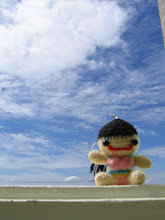
This week , I'm gonna write about the linkage between the lecture and 'Borat' , the movie that we watched in the class. The lecture is about simulation , what is real and what is simulated. The boundary of these two words is presently vanishing , people can't figure out what is real and what is not. First , when I watch the movie , I can't understand how these two things , simulation and Borat , are related. But when I watch it further , there is one seen , the weather guy scene , he is talking with empty screen different from the on air one , that's the map and moving graphic on. Borat can't understand what that weather guy is doing because he is looking at the different view from the audience. The audience see the representation of the geography , map , with the simulation of the weather on it. That's all I can see at the first time. When I rethink about it , I found that the movie itself is the simulation of the real situation that can be happen or can't be. In this case , I think it is hardly happen but the film maker try to make us get into it and make us believe that it's happened. The way they make this film , not intently frame our perception for a beautiful scene , makes the audience easily believe that it's happened and blurs the boundary between the truth and fiction. The last thing , in my opinion , I do not like this film , it's not my taste, but at least it makes me realize something , the world is the big scene of endless drama.









